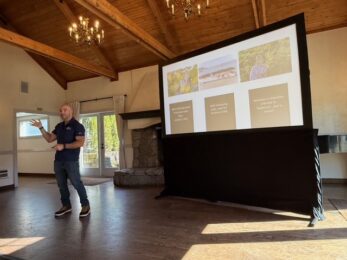When was the last time you attended a meeting you found exciting? According to Rachele Vincent, regional director of sales at Topgolf, who shared engagement strategies at a recent Smart Meetings webinar “Get the Office Out of the Office,” it probably didn’t take place inside your office space. Vincent, who has 10 years of experience building teams and relationships, is passionate about taking the meeting outside of the traditional space.
Vincent offered a brief overview of what makes off-site meetings impactful, what tools you have at your fingertips, as well as tips and tricks to get the most return on your investment.
Create a Cohesive Environment
It turns out that most offices have an average of five generations under the same roof. That’s not only many personalities, but vast differences in behavior, tastes and level of activity. “You have to create a cohesive environment if you have any shot of catering to that type of diversity,” she said.
See also: Over-the-Top Team Building
For on-site meetings, far too much time is spent traveling from one meeting space to another, because booking one room for an entire day is often difficult, something that Vincent refers to as the “meeting room hustle.” Meetings held on site often face a multitude of distractions: unexpected visitors, incessant phone ringing and tasks that take longer than they should.
Employees now spend much of their time in virtual meeting rooms. And while meeting virtually offers flexibility, Vincent knows that the flip side of flexibility distraction. “There is at least one or two of you on this session right now that has had a toddler screaming or a dog barking in the background, some of you are driving and if you are not, you probably have more than one screen up and have projects and emails active on those screens.” Multi-tasking is what humans do. “Whatever environment we are in, we take advantage of it,” she said.
All these distractions don’t exist when meeting face-to-face. The presenter is physically present and has control of the environment, which demands audiences’ undivided attention. In person, the presenter is able to observe the engagement levels of the audience and can adjust their presentation accordingly, allowing presenters to communicate with their audience more effectively.
The Payout
“In business, we have to prove the pay out: what’s in it for me, what’s in it for them, what’s in it for the company,” Vincent said. In fact, 96 percent of small business owners say that in-person meetings are worth the investment. As a result of meeting face-to-face, there is increased retention, improved communication, communal strategic thinking and deeper trust.
“Meetings and events account for over $325 billion in direct spending and is responsible for 2.5 million jobs. Why? Because it pays off,” Vincent said. “Delivering a message that actually resonates with your workforce is basically priceless.”
3 Must-Haves for ROI
Pre- and post-meeting work are of the utmost importance. And of all the factors that go into setting an agenda, the most important one is to be realistic. Setting an agenda well in advance of the meeting is the best way to make sure that everyone will stick to the plan. Vincent recommends carving out time for brainstorming, a portion of meetings that could potentially take up more time than planned.
“We see many off-site events fail because participants are overloaded with data-dense content,” she said. Vincent recommends moving this data review to prereading to save time for meaningful dialogue.
Vincent says, “it’s vital when building your program that you give attendees a true sense of purpose.” For instance, if there is a big problem that attendees have been trying to tackle, communicate this goal with attendees to help them connect emotionally.
Real engagement translates into ROI. Vincent recalled a time when she had content that she thought would hit well with her attendees; much to her dismay, attendees were not engaged, and she was disappointed. A few months down the line, she used the same content but with a different speaker, who added a new spin. Attendees were excited and even congratulated Vincent on a job well done. Why was it that attendees were bored at one point but engaged at another? Different voice. A voice that people hear every day doesn’t have the same impact as an outside one does. And if it’s new content, then that’s even better.
When attendees have the opportunity to do something for others—something as small as a toy drive—it reminds attendees that the company cares and has a positive impact on the community.




